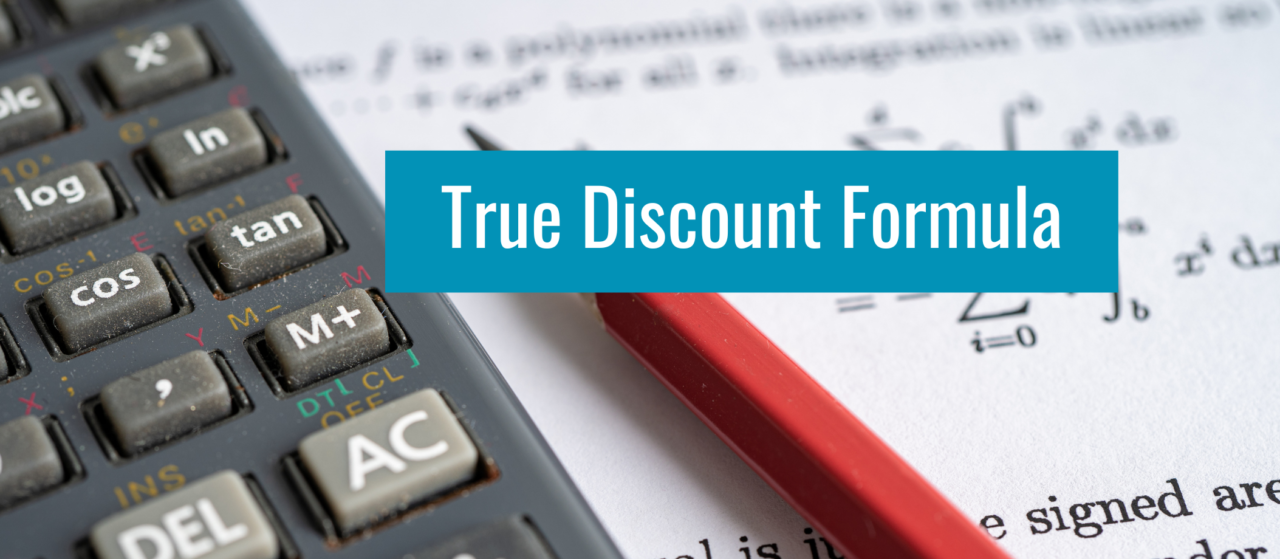So, many a times we are faced with a situation wherein due to the mathematical complexities the true value received or given is not clear. One such regular complexity of finance in daily life is experienced in the concept of “True Discount”. In this article , I will explain not only true discount but also true discount formula.

What is True Discount Formula?
The true discount formula any calculation is as follows;
P= G X (1+Q/100) N-G
Where,
- P denotes the true discount,
- G Represents the present value of that item or sum
- Q represents rate of interest( simple interest)
The above true discount formula has been derived from the relation of simple interest and true discount, which is;
P= (G x N x Q)/100
Where, N is nothing but the duration.
True Discount Example
So, let me explain the application of true discount formula with a very easy example.
Lets suppose A borrowed 1000 from B & Agreed to pay 5% Interest in one year. Hence, the true discount in this case would be;
1000 x 1 x 5 /100= 50. Hence the true discount is nothing but 5% of the amount of money lent to B. But its application can be better understood on why this calculation is actually done. So lets assume that B goes to a bank after 6 months and says that I am in need of some funds and A owes me 1050. So the banker calculates the true discount for 6 months which is
1000 x 5 x 0.5/ 100=25.
So the banker gives B 1025 and will collect 1050 from A after 6 months making a gain of 2.5% interest.
True Discount Questions for Practice
Question 1: True Discount Questions
A bill of $1,500 is due in 3 months, and the true discount is $30. Calculate the rate of interest per annum.
a) 1%
b) 2%
c) 3%
Answer 1: The formula for true discount is: True Discount=Principal×Rate×Time100+Rate×TimeTrue Discount=100+Rate×TimePrincipal×Rate×Time
Given, True Discount = $30, Principal = $1,500, and Time = 3 months.
Let the rate of interest be RR.
30=1500×R×312100+R×31230=100+R×1231500×R×123
Solving this equation, we find R≈2%R≈2%.
So, the correct answer is b) 2%.
Question 2: True Discount Questions
If the true discount on a sum of money is $40, the rate of interest is 5% per annum, and the time is 6 months, find the principal amount.
a) $800
b) $1,000
c) $1,200
Answer 2: Principal=True Discount×100Rate×TimePrincipal=Rate×TimeTrue Discount×100
Given, True Discount = $40, Rate = 5%, and Time = 6 months.
So, the correct answer is a) $800.
Question 3: True Discount Qustion
Find the true discount on a bill of $2,000 due in 9 months at an annual rate of 8%.
a) $120
b) $144
c) $160
Answer 3: True Discount=Principal×Rate×Time100+Rate×TimeTrue Discount=100+Rate×TimePrincipal×Rate×Time
Given, Principal = $2,000, Rate = 8%, and Time = 9 months.
True Discount=2000×8×912100+8×912True Discount=100+8×1292000×8×129
Solving this, we find True Discount ≈ $144.
So, the correct answer is b) $144.
Question 4: True Discount Question
A bill of $600 is discounted for 4 months, and the true discount is $24. Find the rate of interest per annum.
a) 4%
b) 6%
c) 8%
Answer 4: Rate=True Discount×100Principal×TimeRate=Principal×TimeTrue Discount×100
Given, True Discount = $24, Principal = $600, and Time = 4 months.
Rate=24×100600×412=24×100200=12%Rate=600×12424×100=20024×100=12%
So, the correct answer is c) 8%
Question 5: True Discount Qustion
If the true discount on a bill is $90, the rate of interest is 6% per annum, and the time is 1 year, find the principal amount.
a) $1,500
b) $1,800
c) $2,000
Answer 5: Principal=True Discount×100RatePrincipal=RateTrue Discount×100
Given, True Discount = $90, Rate = 6%, and Time = 1 year.
.
So, the correct answer is a) $1,500.



